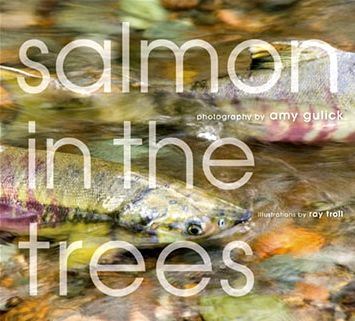
reference-image, l
(article, Amy Gulick)
[%pageBreakSettings nobreak=true][%adInjectionSettings noInject=true] h3. From the section "Salmon Time" Cruising up Chatham Strait, I jerk my head in all directions as hundreds of salmon erupt from the sea like popcorn bursting into the air. It’s salmon time in the Tongass. A time when bears get fat and fishermen don’t sleep. A time when eagles shriek and creeks sing. A time to indulge my taste buds. [[block(sidebar). h1. About the book and author Winner of the 2010 Independent Publisher Book Award, Salmon in the Trees is a collection of photos and essays that tell the story of Alaska's Tongass rain-forest ecosystem, where "salmon grow trees, and trees grow salmon." Amy Gulick is an award-winning photographer and writer whose work has appeared in numerous publications. Reprinted by permission of Braided River/Mountaineers Books (2010). For more information, go to salmoninthetrees.org. ]] In Sitka, I ask a local where to go for the best salmon in town. He advises me to meet someone fast and get invited over for dinner. Luckily, this isn’t difficult. People are generous with the bounty in this fruitful part of the world. In Craig, a charter-boat captain treats me to grilled coho brushed with a pineapple glaze. At a Native gathering in Kake, my entire being purrs upon savoring king salmon still warm from the smokehouse. In Hydaburg, a family serves me smoked sockeye, pickled wild beach asparagus, and Yukon gold potatoes. Kings and queens never had it this good. I start an informal poll and ask everyone I meet if eating salmon ever gets old. Everything in moderation, right? Wrong. Not a single person hesitates before answering with a definitive “no.” For me, wild salmon is always a treat. For the people in Southeast Alaska, it’s a way of life. Summers are spent catching, cleaning, smoking, freezing, and canning for personal use. The commercial salmon industry is a mainstay of the local economy and has been certified as sustainable by the Marine Stewardship Council. Catch numbers, area openings and closures, and fish politics are headline news. I like this way of life — spending time harvesting, preparing, and sharing delicious and nutritious wild food. It feels right. It builds community. It builds entire cultures — just ask the Native folks. To the wild salmon of the Tongass, I bow my head in respect and thanks. [%image feature-image float=left width=600 caption="Canning smoked king salmon at the Dog Point Fish Camp."] Grilled Wild Alaska Salmon Wild Alaska salmon is so flavorful that to serve it with competing flavors is to disrespect the fish. The key to good salmon is to buy it as fresh as possible, be sure that it’s wild-caught, and know that it tastes best when shared. Wild Alaska king or sockeye salmon fillet, skin on Light-tasting olive oil Brown sugar Paprika Kosher salt Black pepper Rinse the salmon and pat it dry. Brush both sides of the fish lightly with olive oil. Sprinkle brown sugar and paprika evenly on the flesh side, gently pressing the rub into the fish. Top off with a little salt and pepper. Sear the salmon on a hot grill, flesh side down. Carefully flip the fish over so the skin side is down. Remove the salmon from the grill when white opaque droplets begin to form on the fish. The flesh should be firm on the outside but still a little rare in the middle, as it will continue to cook after it’s off the grill. Take great care not to overcook the fish. Enjoy!

reference-image, l

feature-image, l